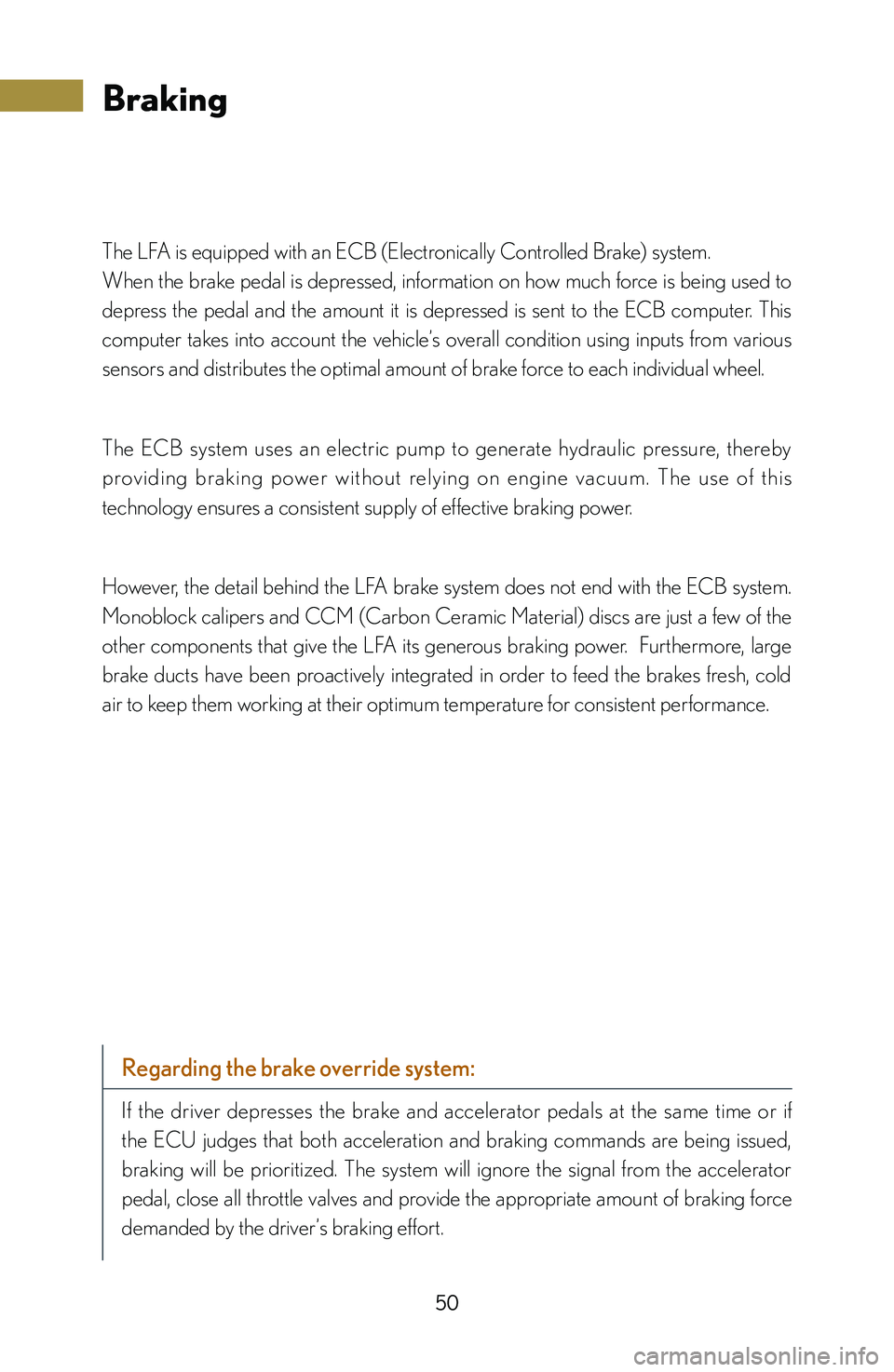Page 34 of 128

32
When the driver depresses the accelerator pedal, a signal is sent to the ECU where
it is interpreted and used to control the throttle valve angle. This is all performed
electronically without a conventional cable linkage.
The throttle valves are opened and closed by a pair of electric motors, one for each
bank of cylinders. There are a total of 10 individual throttle valves, one for each
cylinder. This configuration minimizes the amount of air between each combustion
chamber and its corresponding independent throttle valve, promoting instantaneous
throttle action for outstanding engine response.
Furthermore, this drive-by-wire technology is able to tailor specific throttle valve
angle strategies to each available driving mode. Depending on which driving mode
is selected, depressing the accelerator pedal the same amount will result in a different
throttle valve angle. This variable control results in engine characteristics better suited
to the driver’s intentions and driving conditions.
■
■Accelerator pedal mechanism
A f l o o r- m o u n t e d a c c e l e r a t o r p e d a l
allows the fulcrum to be moved closer to
the floor and the driver's heel. Depressing
the pedal actuates a rod, which moves
through a sensor. The pedal has a 1.48 in.
(37.7 mm) stroke and the sensor is able
to precisely detect movement down to
0.03 in. (0.8 mm) in order to provide a
more direct feel.
Pedal stroke
Fulcrum
Accelerator pedal (Position sensor judgment)
Pedal
released Pedal
fully
depressed 0 1.48 (37.7)
Pedal stroke [in. (mm)]
Accelerating
Page 52 of 128

50
Braking
The LFA is equipped with an ECB (Electronically Controlled Brake) system.
When the brake pedal is depressed, information on how much force is being used to
depress the pedal and the amount it is depressed is sent to the ECB computer. This
computer takes into account the vehicle’s overall condition using inputs from various
sensors and distributes the optimal amount of brake force to each individual wheel.
The ECB system uses an electric pump to generate hydraulic pressure, thereby
providing braking power without relying on engine vacuum. The use of this
technology ensures a consistent supply of effective braking power.
However, the detail behind the LFA brake system does not end with the ECB system.
Monoblock calipers and CCM (Carbon Ceramic Material) discs are just a few of the
other components that give the LFA its generous braking power. Furthermore, large
brake ducts have been proactively integrated in order to feed the brakes fresh, cold
air to keep them working at their optimum temperature for consistent performance.
Regarding the brake override system:
If the driver depresses the brake and accelerator pedals at the same time or if
the ECU judges that both acceleration and braking commands are being issued,
braking will be prioritized. The system will ignore the signal from the accelerator
pedal, close all throttle valves and provide the appropriate amount of braking force
demanded by the driver’s braking effort.
Page 64 of 128
62
■
■Engine oil pressure gauge
The engine oil pressure gauge displays the engine oil pressure from 0 to 800
kPa. The rapid response of the TFT LCD panel allows for the fluctuations in engine
oil pressure that occur with engine speed to be displayed instantly. The engine oil
pressure is also affected by other factors such as engine oil type, temperature and
deterioration. If the engine oil pressure is too low, the master warning light comes on
and the “Engine oil pressure low” warning message is displayed. Checking the engine
oil pressure regularly aids understanding of the condition of the engine and engine oil.
During high-speed driving: approximately 400
to 800 kPa
(changes depending on driving conditions)
[Outside air temperature approximately 68°F
(20°C)]
When oil pressure is insufficient
An oil pressure sensor is installed near the oil filter.
The oil pressure measurements are processed by the ECU and displayed by the
engine oil pressure gauge.